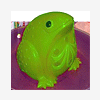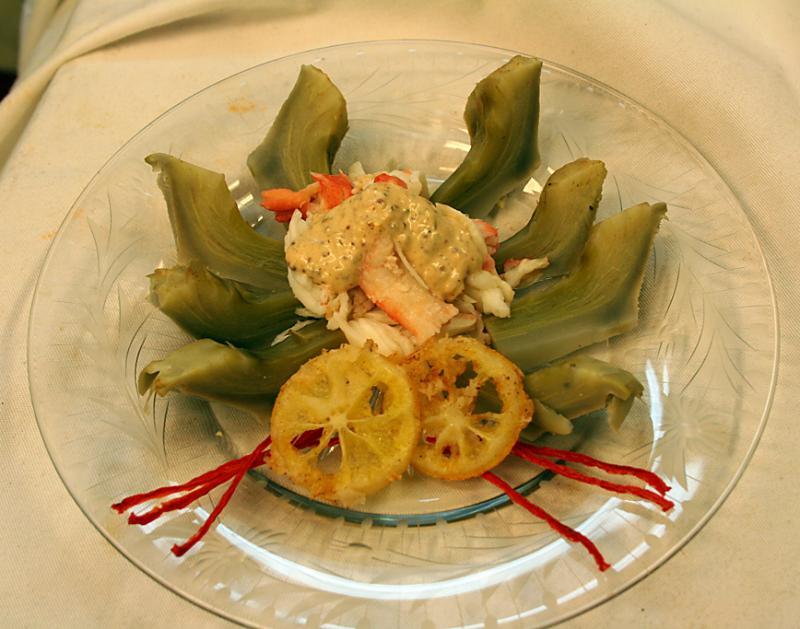-
Posts
8,089 -
Joined
-
Last visited
Content Type
Profiles
Forums
Store
Help Articles
Everything posted by Dave the Cook
-
There are lots of opinions about stock. Here's mine: 1. Leave the skin on. Lots of collagen to render, which will give you very gelatinous product. 2. Give up the meat to the stock. It will make it more obviously porky. 3. I use two pounds of meaty bones to yield one quart of stock, and I don't bother with vegetables. I've yet to see any reason to change that.
-
Blais: Chef, how come you don't cut down just the bone with that fish? Thomas: It's wasting time. The more fish you waste, the more you have to work.
-
The Screwpull works well -- for as long as it stays together. Maybe they've changed the way they're assembled, but after having two literally fall apart at the seams (that's thirty bucks in the trash), I went back to an articulated waiter-style screw.
-
Janet (JAZ) and I are in. We'll be driving too, so we can haul equipment and the like -- including, if it's helpful, 3 dozen properly-sized glasses that we use for our cocktail classes, as well as 18 champagne flutes. Along those lines, we'd love to be Chris A's minions in presenting that workshop if it's a go. We're also happy to conduct a cooking class in pretty much anything savory, as that's one of the things we do to make ends meet. (We're also happy not to; mostly we're looking forward to meeting everyone and enjoying three days of outstanding food and drink.)
-
This works well. During an extended pistachio session the other night, it was successful five out of six times.
-
How did you smoke the tomatoes? Sliced and smoked? Hot or cold smoke? I'm not sure how Nick did it, but I cut them in half and cold-smoked for four hours. They were excellent in a cooked red salsa.
-
Yep. This recipe at Epicurious is a nice change from the usual bechamel technique. You blanch broccoli florets (seems like thinly sliced stems would work, too), then mix them with cream and Dijon-style mustard. The topping is a combination of sauteed onion, garlic and bread crumbs, to which you add dry and Dijon mustards. Once that's cool, add some parmesan cheese and use it to top the broccoli. Pop it in the oven until the cheese browns.
-
Is this a plated dinner or a buffet? If the latter, and you think your guests might heap their plates with samplings of all three proteins, I'd go for something that benefits from being sliced thin -- and you'll get better portion control. That points to tri-tip, I think. I'm not sure what a sirloin ball is. Is that the same as a strip loin roast?
-
I had a potato explode on me in a conventional oven several (maybe many) years ago. I hadn't pricked it, but it's just one data point out of the thousands of unexploded potatoes I've baked. My guess is that much depends on the integrity of the potato skin; porosity probably varies a great deal. There is another reason to do it, however, and that's to allow more moisture to escape from the potato flesh, helping to ensure a dry, fluffy result. Since reading this (I can't remember where) I give my bakers 15 to 20 deep stabs with a fork prior to baking. It seems to help, though it might just be one of several self-delusions I carry about. It certainly doesn't hurt.
-
Things may be different where you are, but in many of the US states, the realtor works for the seller, even though their demeanor towards you may suggest otherwise -- that's the art of selling. That's not to say that any of them are unscrupulous, only that you should remember who's signing the paycheck.
-
A scan of Texas legal statutes and regulatory rules doesn't turn up anything regarding a ban on white grapefruit production. However, the red grapefruit is the "state fruit," and growers' groups, in conjunction with the state, have made the practice of growing whites a non-starter. If you can benefit from cooperative advertising and public relations, why try to swim upstream? In other words, it's not that it's illegal to grow white varieties in Texas; it's that no one bothers. Texas is the second- or third-largest US state in terms of production, depending on the year and which documents you consult. Florida produces the most -- more than Texas, Arizona and California combined (grapefruit isn't commercially produced anywhere else in the US). Most of the crop is juiced, and most is exported (the US is by far the world's leading exporter), whether as juice, whole fruits or segments. That includes a large quantity of white fruit to places like Japan, where it's much more popular than pink/red. So it seems that whites are more valuable as an export, making it relatively scarce in the country where most of it is grown. Of course, consumer preference for pinks and reds drives this. Still, I'm surprised by the price of whites in New York and New England. I can get white grapefruit pretty much year-round here in Atlanta. I have a receipt from 9 December 2010 showing 59 cents each.
-
If you've got a vacuum sealer, a probe thermometer, a big enough pot (and a rack to hold the bagged meat off the bottom of the pot), plus a decent attention span, it's easy to rig an adequate sous-vide setup on your stovetop. Convection in the open pot seems to provide adequate circulation; you just need to pay attention to the water temperature. For the last two Thanksgivings, I've done turkey breast this way at 60°C, give or take (my range is pretty stable) for 2-1/2 hours. I'm unlikely to ever cook turkey breast any other way.
-
Dan -- is there some reason you want to use a smoke gun? This seems like a pretty straightforward use for a cold-smoke box. A guy on BigOven (our member vogelap, as a matter of fact) posted a technique here: 80°F for 20 minutes.
-

Where can I purchase curing salt in Atlanta?
Dave the Cook replied to a topic in Southeast: Cooking & Baking
In case anyone is still looking, Bass Pro Shop (I-85 at Sugarloaf Parkway, adjacent to Discover Mills) carries LEM Cure, which is pink salt. They also carry grinders, casings, vacuum sealers (and bags), and a bunch of other charcuterie-related stuff. I haven't compared prices. -

Mango liqueur - how do I keep it from being disgusting?
Dave the Cook replied to a topic in Spirits & Cocktails
That's about what I pay here in Atlanta. But FdC also has ridiculous pricing on 1.75s: about $15. That's three bucks for an additional liter. -
We had a failure, too, and as a result, there's bacon in various forms all over the place. My brother sent us some beautiful king crab, and that led to the idea of a dish that combined crab, artichoke, lemon, red bell pepper and bacon. For Christmas, I had received this modernist starter kit, and I decided to try something simple, like the bacon powder from the Alinea cookbook. I made a half-recipe, as the kit only provides about 50 grams of powder. The problem was that it didn't taste much like bacon. So I rendered another 150 grams, to get another 50 grams of bacon fat. Adding this to the "powder" did make it taste more like bacon -- a lot, in fact -- but it was no longer a powder. And the longer I stirred, the gooier it got. So I took some bacon bits -- the crispy meat from which I'd rendered the fat -- and put it in the dehydrator. After about an hour at 150°F, it was drier, but of course, fat doesn't evaporate, at least not at that temperature. I ground it up anyway, just to see what would happen. Very tasty paste is what happened, though it lacked any visual appeal. Anyway, we mixed that into a remoulade, and used that to top a reconstruction of a crab, more or less: The "antennae" are dehydrated red bell pepper; the "eyes" are slices of Meyer lemon, dredged in Wondra and deep-fried. The second, and final dish, because it was already getting close to midnight, was coffee-rubbed rack of lamb, a cake of fried grits, and a fancy version of red-eye gravy. Tomato chips were a garnish.
-
They're pretty low in proof; I'd be more inclined to treat them like spiced simple syrups in sours, starting with medium to dark rums or maybe applejack as base spirits.
-
Anything new on the dehydrator front? I'm in the market for one.
-
For Thanksgiving, we ground up some andouille and cooked it off. Then we mixed the sausage, with some of the rendered fat, into the cooked yolks along with finely chopped scallion, mayo, and Creole mustard. We piped the mixture into the halved whites and garnished with something I've forgotten. They disappeared pretty quickly -- but then, that's what happens to pretty much any deviled egg.
-
I'll be interested to hear what peeps have to say about artichoke selection. A dish I'm planning for New Year's Day requires excellent artichokes, and I've had the same experience as you. When I was about Bebe's age, I would steal the bone from the round steak my mother fried for dinner and suck the marrow out before it got to the table. At some point, she quit making it, and I forgot about it. It was a good 35 years before I had marrow again, thanks to Fergus Henderson.


